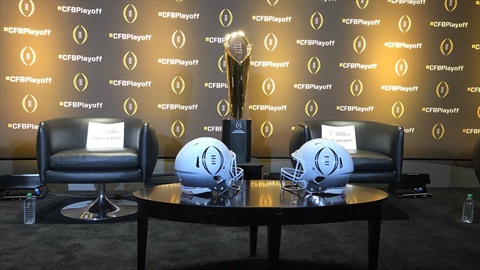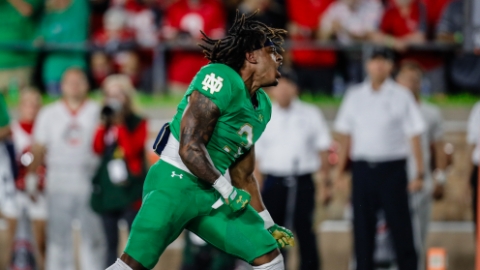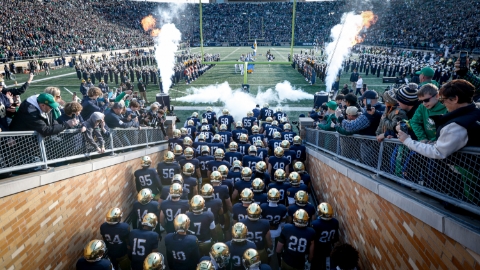
Recruit. Retain. Replace.
The three Rs mean something different outside of college football, but that’s what they mean for roster building with a program. Teams have to recruit players to sign with the program. They then have to keep them in the program and develop them. Inevitably, they leave and have to be replaced.
That last part isn’t a four year thing these days. Players are transferring all the time and those players have to be replaced on the roster. Oftentimes it’s through high school recruiting. Some programs have gone the transfer portal route to replace those scholarship players on the roster in response to several players transferring or simply trying to build their roster that way.
Last week I dove into Blue-Chip Ratio in 6 Thoughts, but that is really only a reflection of how a program is recruiting. It doesn’t really tell the whole story of what a roster looks like in terms of raw talent because 1) a lot of teams who have recruited really well have done a poor job of keeping that talent on campus and 2) it doesn’t cover what teams are doing to replace that talent with transfers.
Texas A&M signed 58 blue-chips (4 and 5-star) recruits from 2020-2022. Those are the players who would make up the heart of their roster this season. 27 of them are no longer on the roster. (Three of them went to the NFL) There’s a huge difference between 58 and 31.
Texas signed 50 blue-chips over those three cycles. 19 are gone. LSU signed 41. 17 are gone. Oregon signed 39. 22 are gone.
That’s the kind of thing that pretty much makes their BCR invalid. If you don’t keep those players, then the percentages can look drastically different.
Notre Dame is one of 14 programs who signed 33 or more blue-chips in the 2020-2022 classes. They signed 41 during that time and 30 of them are still with the program. Including Michael Mayer, who left early for the NFL, they retained 31 (75.6%).
That’s a healthy number. It’s actually the healthiest number out of any of the 14 programs who had a coaching change. The five programs above them are Georgia (80.7%), Ohio State (77.6%), Penn State (78.8%), Clemson (79.5%), and Michigan (78.4%). All of them have had the same head coach in place for at least four years.
Behind Notre Dame is Alabama (71.0% and more on them later), Miami (67.7%), Oklahoma (65.9%), LSU (65.8%), Texas (64.0%), Texas A&M (58.6% WOOF, Jimbo strikes again), Florida (53.9%), and Oregon (46.1%).
The percentage matters, but it’s the total number that better exemplifies the three Rs. Add in any 5th and 6th year blue-chips (not many), incoming freshmen ranked as blue-chips, and those with a blue-chip transfer ranking (no points for guys who were busts at previous programs) and this is what these rosters actually look like with blue-chips out of the 85 scholarship limit. I’m open to any suggestions, but let’s just call this Actual Talent for now. (With USC added because they have 11 blue-chip transfers as well as a number of highly ranked freshmen)
Alabama 78
UGA 68
OSU 67
ND 58
Clemson 55
Texas 55
LSU 54
OU 54
A&M 52
PSU 49
Oregon 49
Michigan 48
UF 47
USC 46
Miami 46
Now, this doesn’t mean that Notre Dame is the fourth most talented team in college football this year. There’s context that gets missed with programs who have elite draft-eligible talent versus others who are younger and reloading.
What it does mean is that they have done a good job of recruiting, retaining, and replacing. In other words, roster building. That 58 was 44 two years ago and it was 53 last year. It will take more than just the total number to catch the three above them, but having 14 more on the roster than they did a couple of seasons ago is significant.
2. Notre Dame needs to sign more top-50 recruits. It helps to identify and develop elite talent who aren’t ranked there (Joe Alt and Benjamin Morrison) and also to bring in proven transfers who have played at a high-level already (Sam Hartman), but doing that and signing more Michael Mayer and Kyle Hamilton level prospects is what’s needed.
It’s crazy to look at how many of the top players across the country have ended up transferring. 17 of the 2020 ISD Fab 50 have finished or will finish at a program that they didn’t sign with originally (18 of the 247Sports composite). There’s already 14 from the 2021 Fab 50 who will do the same (ditto for the composite).
Again, it’s not just about recruiting. It’s about retaining.
In terms of top-50 recruits on the current rosters of Notre Dame opponents, Ohio State has 10 (from 2020-2022). Clemson has seven. USC has six. There are six playing for Notre Dame on the roster who I had in the Fab 50 over those three years.
They are Jordan Botelho, Chris Tyree, Blake Fisher, Aamil Wagner, Jaylen Sneed, and Josh Burnham.
Outside of Wagner, who is likely only to play much this season if there is an injury, the other five are players who could help swing the balance of this season. The expectation is for Fisher to continue to progress from last year and be one of the top tackles in college football. If he’s an All-American candidate along with Joe Alt, that’s a great situation for Notre Dame.
Notre Dame wants Jordan Botelho to produce as a pass rusher in a bigger sample size this season. They would love it if Chris Tyree could add a consistent explosive element with his speed as he makes the transition to receiver. Everyone would love to see Sneed make the leap and be Havoc producer in a significant role. And if Burnham gets to a point this season where he’s a legitimate presence as an edge rusher, then that could be huge for the defense.
It’s not likely that all that will happen with that group of players, but if it even happens with a few of them, it can change the trajectory of the season for the Irish.
3. Out of all of those programs I listed, Notre Dame has the most 5th (or 6th) year players who were composite 4-star recruits. They have six of them: Zeke Correll, Andrew Kristofic, NaNa Osafo-Mensah, Jack Kiser, JD Bertrand, and Howard Cross.
Those players have a few things in common. The number one thing is that they are still on the team now because they are good players. They will all contribute in some way, but Correll, Bertrand, and Cross are returning starters who will stay starters.
The next thing is that none of them are likely going to be NFL Draft picks. A few of them might end up playing in the NFL, but for various reasons, none are viewed as draftable prospects today.
The next thing is something they probably should have all had in common. Osafo-Mensah, Kiser, Bertrand, and Cross were low 4-stars (not in the top-300). Correll and Kristofic probably should have been because both had limitations with their size that limited their position flexibility. Correll is a fit at center, but not at guard. Kristofic is a fit at guard, but not at tackle like he was projected.
This probably sounds like I’m veering towards “Notre Dame needs to sign more top-50 prospects blah blah blah”, but that’s not my intention. This is more about not everyone on a roster has to be an NFL prospect to be a “hit” or a good take.
I know rankings in recent years have become a lot more about whether or not a player gets drafted by the NFL or not, but it’s way too simple to only use that as a way to judge if a player’s ranking was appropriate. Everyone wants to have studs on their roster who end up being high picks after three or four years, but these six guys are important pieces for Notre Dame and there have been many like them who have been a big part of the culture and the success of the program. These types of players will always matter.
4. So many programs have taken advantage of the added year of eligibility the NCAA granted because of the disjointed 2020 season. It’s had a massive impact on rosters across college football.
Notre Dame has four “bonus year” players this season in Sam Hartman, Javontae Jean-Baptiste, Thomas Harper, and DJ Brown. They have benefited from Kurt Hinish, Jayson Ademilola, and TaRiq Bracy taking advantage of an extra year as well.
That’s nothing compared to what some other teams are doing. NC State has nine projected starters this season who are utilizing their extra year. That September matchup looks drastically different without that.
It’s not anything worth complaining about because all programs are taking advantage of it, but it is startling to see a team have 40% of its starters come from players who would normally be out of eligibility.
The 2024 season is the last ride for “bonus year” players. True freshmen who played in 2020, like Notre Dame’s Rylie Mills, Jordan Botelho, and Clarence Lewis, can have a fifth season of playing. Players from the 2019 class redshirted as freshmen essentially got what amounted to a double redshirt so Correll, Kristofic, Osafo-Mensah, Cross, graduate transfer Xavier Carter, and the three senior fifth year linebackers on the roster are all eligible to come back for a sixth year.
It’s way too early to predict who might be back next year out of that group, but how many of them do is largely going to be determined by the development of the 2022 and 2023 recruiting classes. If it looks like they are going to make up a lot of the projected two-deep in 2024, then we’ll see less players using that extra year at Notre Dame.
One thing we’re definitely going to see less of is players in the transfer portal after 2024. This fall is the last hurrah for the 2018 class. DJ Brown is the only one left at Notre Dame, but seven other former Notre Dame players are still playing for other programs in 2023. Next year will be the end for everyone from the 2019 and 2020 classes. The number of graduate transfers is going to decrease significantly and there won’t be teams trying to run as many players off because they won’t be able to add the same number of fifth and sixth year players to plug holes on the roster.
There’s a win now mentality at the majority of programs, so of course they are going to take advantage of as many “bonus year” players as possible. Notre Dame will have the best roster they can put together in ‘24 and I doubt that they are going to make decisions for the future if they know a fifth or sixth year player can help them more now, but tomorrow is coming soon for everyone in college football so evaluating their own talent on the roster this season will be critical in deciding how many veteran players they want to keep after this season.
5. Alabama signed 69 blue-chip recruits in the 2020-2022 recruiting classes.
That’s 12 more than Georgia and 11 more than Ohio State. That’s 25 more than Clemson. That’s 28 more than Notre Dame and LSU. That’s 32 more than Michigan.
That’s 46 more than USC and 48 more than Florida State!
There’s a lot of 5-stars in that 69 too so it’s an avalanche and quality and quantity. Maybe it’s just the nature of Nick Saban’s program and how he runs things or the fact that the turnover on his staff is more frequent than others, but it is pretty startling that 23 of those recruits are gone from Alabama (three were drafted by the NFL). They literally lost as many blue-chip recruits as USC signed over that same time period.
I can’t argue with the results for Alabama. Oversigning and never stop stopping (shoutout Lonely Island) signing as many elite recruits as possible seems like a pretty sound strategy and they keep winning. They have 10 more blue-chip recruits/transfers on their roster than anyone else this season and being that talented and deep has led to incredible success.
On the other hand, looking at how Georgia has only had 11 blue-chips transfer (and four enter the NFL Draft) from those classes feels like a win for development and culture. It’s not like they don’t recruit at an insane rate, but that doesn’t seem to scare many of the players off when they aren’t stars.
Kenny McIntosh could have been a lead back for a lot of programs way earlier in his career, but he stayed at Georgia despite not getting more than 58 carries in a season until 2022. Robert Beal committed to Notre Dame when Brian VanGorder was the defensive coordinator and signed with Georgia in 2017. They managed to keep him on the roster after he almost transferred back in 2020 and he was one of their best pass rushers the last two years.
Those are two of several examples of players who could have gone somewhere else, but stayed, contributed, and eventually got drafted. It obviously helps to win as much as they have, but it’s not a cure-all. Just look at Alabama.
They signed 12 top-100 prospects in the 2019 class. One of them was in the NFL, four of them were starters, and two were backups for Alabama last season. Five had already transferred. Only two out of those dozen, offensive tackle Evan Neal and defensive back Jordan Battle, ended up becoming All-SEC players.
Notre Dame is in the same boat with many other programs where they sign a good number of elite recruits, but they’d obviously like to sign more. Is there a point where it gets to be too much, though? That seems like a ridiculous question to ask. However, Alabama is going to have 78 out of 85 scholarships held by blue-chip recruits/transfers and that should make them a heavy favorite to win another national championship, but they aren’t.
6. Last year at Irish Invasion, CJ Carr, Cam Williams, Jack Larsen, and Aneyas Williams all competed as well as current 2024 targets Brauntae Johnson, Darrion Dupree, and Kaleb Beasley. The camp also featured Michigan running back commit Jordan Marshall, Ohio State wide receiver commit Mylan Graham, Ohio State linebacker commit Garrett Stover, Clemson tight end commit Christian Bentancur, Georgia quarterback commit Ryan Puglisi, and Michigan safety commit Jacob Oden.
It didn’t get hyped up as a loaded camp, but looking back at it now, there was a lot of talent competing. I don’t know how this year’s Irish Invasion camp will compare to it, but looking at how four key commits and two key targets competed last year, it’s something people should be paying attention to this weekend.
I know the official visits for the 2024 class will get most of the attention, but this is when 2025 and 2026 recruiting will really start to heat up. Notre Dame has offers out to 123 2025 prospects already, but June (aka camp season) is when those offers start to come more into focus. It’s when the board gets a little bit more defined after working players out in person at Invasion and other position camps. Bryce Young earned his offer at one last year.
The fun part about it is that it’s less about a list of players to watch who will be there. It becomes about which players are the ones to watch for Notre Dame going forward. We’ll know a lot more about that next week than we do right now.
Blue 84 Navy Notre Dame Fighting Irish 2023 NCAA Men's Lacrosse National Champions T-Shirt




